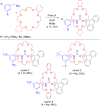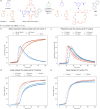Autonomous Dynamic Control of Crown Ether Cargo Release from [2]Rotaxane Carriers in a Piperidine Oscillator
- PMID: 40528382
- PMCID: PMC12232326
- DOI: 10.1021/jacs.5c05460
Autonomous Dynamic Control of Crown Ether Cargo Release from [2]Rotaxane Carriers in a Piperidine Oscillator
Abstract
Chemical oscillations play a fundamental role in biological systems, yet their synthetic counterparts remain challenging to implement with functional outputs. Here, we report a piperidine-based chemical oscillator that autonomously drives periodic cleavage of a [2]rotaxane carrier, leading to controlled cargo release. The system operates through self-sustained oscillations, triggering rotaxane cleavage and the release of a crown ether cargo. Crown ethers were selected for their reactivity distinct from piperidine, while Fmoc-protected benzylamine rotaxane structures allowed for straightforward carrier modification. For all tested carriers, a piperidine pulse is present and occurs simultaneously with carrier cleavage, yielding up to 95% cargo release. Under flow conditions, periodic cargo release was sustained without extensive reoptimization, demonstrating the robustness of the system. Additionally, by adjusting space velocity, trigger concentration, and inhibitor levels, the oscillation period was varied by up to 2.5 h, with cargo release amplitude changing more than 3-fold. This work demonstrates the potential of catalytic oscillators to regulate downstream processes, paving the way toward construction of complex dynamic chemical systems.
Figures






Similar articles
-
Surveillance for Violent Deaths - National Violent Death Reporting System, 50 States, the District of Columbia, and Puerto Rico, 2022.MMWR Surveill Summ. 2025 Jun 12;74(5):1-42. doi: 10.15585/mmwr.ss7405a1. MMWR Surveill Summ. 2025. PMID: 40493548 Free PMC article.
-
Nucleic Acid Nanocapsules as a New Platform to Deliver Therapeutic Nucleic Acids for Gene Regulation.Acc Chem Res. 2025 Jul 1;58(13):1951-1962. doi: 10.1021/acs.accounts.5c00126. Epub 2025 Jun 9. Acc Chem Res. 2025. PMID: 40491030
-
Signs and symptoms to determine if a patient presenting in primary care or hospital outpatient settings has COVID-19.Cochrane Database Syst Rev. 2022 May 20;5(5):CD013665. doi: 10.1002/14651858.CD013665.pub3. Cochrane Database Syst Rev. 2022. PMID: 35593186 Free PMC article.
-
Comparison of Two Modern Survival Prediction Tools, SORG-MLA and METSSS, in Patients With Symptomatic Long-bone Metastases Who Underwent Local Treatment With Surgery Followed by Radiotherapy and With Radiotherapy Alone.Clin Orthop Relat Res. 2024 Dec 1;482(12):2193-2208. doi: 10.1097/CORR.0000000000003185. Epub 2024 Jul 23. Clin Orthop Relat Res. 2024. PMID: 39051924
-
Systemic pharmacological treatments for chronic plaque psoriasis: a network meta-analysis.Cochrane Database Syst Rev. 2021 Apr 19;4(4):CD011535. doi: 10.1002/14651858.CD011535.pub4. Cochrane Database Syst Rev. 2021. Update in: Cochrane Database Syst Rev. 2022 May 23;5:CD011535. doi: 10.1002/14651858.CD011535.pub5. PMID: 33871055 Free PMC article. Updated.
References
-
- Reese R. L., Chang G. Y., Dupuy D. L.. The Oscillation of the Synodic Period of the Moon: A “‘Beating’” Phenomenon. Am. J. Phys. 1989;57(9):802–807. doi: 10.1119/1.15896. - DOI
-
- Fonkou R. F., Savi M. A.. Heart Rhythm Analysis Using Nonlinear Oscillators with Duffing-Type Connections. Fractal Fract. 2023;7(8):592–592. doi: 10.3390/fractalfract7080592. - DOI
LinkOut - more resources
Full Text Sources

